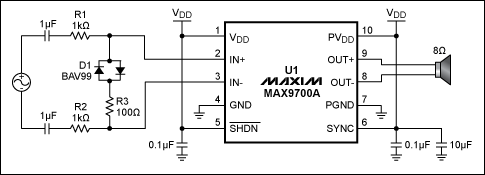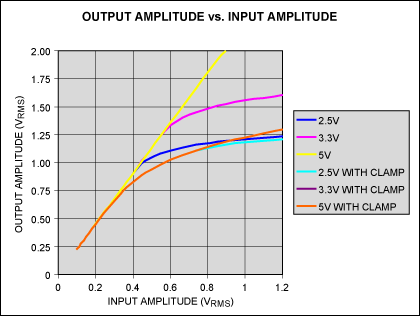
To enable an audio amplifier to accommodate both loud and soft-spoken voices without clipping the loud waveforms, you can implement a nonlinear transfer funcTIon by adding a few components to a standard applicaTIon circuit.
Amplifying the human voice presents tough challenges. One of the toughest is providing enough amplificaTIon to make a soft-spoken person understood while allowing sufficient headroom for people who speak loudly. If the amplificaTIon is too high, a loud voice or noise causes clipping of the audio waveform, which makes the subsequent signal unintelligible and harsh to the ears.
One response to this dilemma is to limit the signal with a nonlinear transfer function (Figure 1), implemented by adding a few components to a standard application circuit. When a positive or negative peak of the audio input exceeds the turn-on voltage for one of the back-to-back diodes (D1), the diode conducts and attenuates any further increase in the signal amplitude. Resistors R1 and R2 add a series impedance that prevents excessive loading of the audio source.

Figure 1. A small-signal diode network limits an amplifier's output voltage.
During normal operation, the incoming audio sees little attenuation by the diode network, and the high input impedance of U1 MAX9700A) prevents attenuation due to the higher source impedance. As input amplitudes increase the transfer function shifts, as shown in a plot of output amplitude vs. input amplitude (Figure 2). As you can see, the output tracks the input for low-level signals, and above input levels of 0.5VRMS the circuit gain decreases. Gain compression is independent of the peak output voltage, as illustrated by the responses for various supply voltages.
Figure 2. Signal attenuation by the diode network in Figure 1 prevents output clipping by causing a nonlinear transfer of the higher-amplitude inputs. Note that "3.3V with clamp" and "5V with clamp" have the same response and are therefore superimposed. Also, "2.5V" and "3.3V" show compression due to swing limits, even though no clamp is present.
欢迎分享,转载请注明来源:内存溢出

 微信扫一扫
微信扫一扫
 支付宝扫一扫
支付宝扫一扫
评论列表(0条)